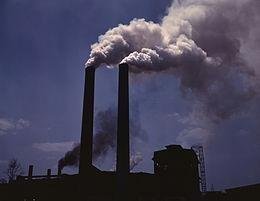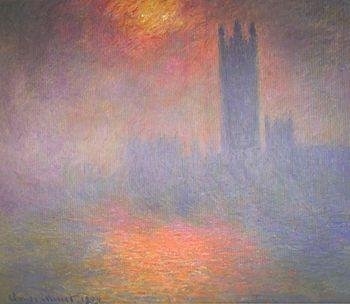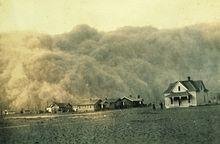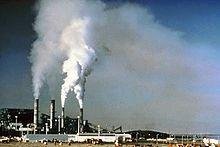POLLUTON SERIES #1: AIR POLLUTION
 image source
image source
Happy Sunday steemians! Today's post is going to mark the beginning of my pollution series and the first topic of choice is AIR POLLUTION.
Air pollution can be defined as the pollution of air by smoke and harmful gases, mostly oxides of carbon, sulphur, and nitrogen. Air pollution happens when harmful or too much quantities of substances which includes gases, particulates, and biological molecules enters into Earth's atmosphere. It can cause diseases, allergies and also death of humans, can also cause harm to other living organisms such as animals and food crops, and may damage the natural or anthropogenic environment. Human activity and natural processes can both cause air pollution.
 image sourceClaude Monet's painting of 19th century
image sourceClaude Monet's painting of 19th century
London smog. It was caused mainly by burning
coal fires
IMPURITIES THAT CAUSES AIR POLLUTION
Carbon dioxide (CO2) - due to it's role as a greenhouse gas it has been mentioned as "the leading pollutant"and "the worst climate pollution". Carbon dioxide is a natural component of the atmosphere, necessary for plant life and released by the human respiratory system. CO2 currently contains about 405 parts per million (ppm) of earth's atmosphere, compared to about 280 ppm in before industrial times, and billions of metric tons of CO2 are emitted annually by use of fossil fuels. CO2 increase in earth's atmosphere has been increasing.
Sulfur oxides (SOx) - is a chemical compound with the formula SO2. SO2 is produced by volcanoes and in many industrial processes. Coal and petroleum contain sulfur compounds, and their combustion generates sulfur dioxide. Further oxidation of SO2, in the presence of a catalyst such as NO2, forms H2SO4, and acid rain. This is a cause for concern over the environmental impact of the use of these fuels as power sources.
Volatile organic compounds (VOC) VOCs is a known outdoor air pollutant. They are classified as either methane (CH4) or non-methane (NMVOCs). Methane is a greenhouse gas which contributes to global warming. Other hydrocarbon VOCs are also major. greenhouse gases because of their place in creating ozone and prolonging the life of methane in the atmosphere. This effect varies depending on local air quality. The aromatic NMVOCs benzene, toluene and xylene may lead to leukemia with prolonged exposure. 1,3-butadiene is another dangerous compound often associated with industrial use.
Chlorofluorocarbons (CFCs) - Are very harmful to the ozone layer, most of its products are currently banned from use in many countries. These are gases which are released from air conditioners, refrigerators, aerosol sprays, etc. On release into the atmosphere, CFCs rises to the stratosphere. Where they come in contact with other gases and do serious damage the ozone layer. This allows harmful ultraviolet rays to reach the earth's surface. This leads to skin cancer, eye disease and cause damage to plants.
Nitrogen oxides (NOx) - Nitrogen oxides, mainly nitrogen dioxide, are ejected from high temperature combustion, and are also ejected during thunderstorms by electric discharge. They can be noticed as a brown haze dome above or a cluster downwind of cities. Nitrogen dioxide is a chemical compound with the formula NO2. It is one of many nitrogen oxides. One of the most major air pollutants, this reddish-brown toxic gas can be characterised by its sharp, biting odor.
Carbon monoxide (CO) - CO is a colorless, odorless, toxic yet non-irritating gas. It has a strangely pleasant smell, It is a produced by the combustion of fuel such as natural gas, coal or wood. Vehicles exhaust are a major contributor of carbon monoxide let into our atmosphere. It creates a smog type formation in the air that has been linked to alot of lung diseases and disorders to the natural environment and animals. In 2013, more than half of the carbon monoxide ejected into the atmosphere was from vehicle traffic and burning one gallon of gas will often emit over 20 pounds of carbon monoxide into the air.
TYPES OF POLLUTANTS
Pollutants that causes air pollution can be put into two groups man-made(anthropogenic) or natural.
 image sourceDust storm approaching
image sourceDust storm approaching
Stratford, Texas
- NATURAL
These pollutants includes dust, sea salt ,
volcanic ashes and gases, smoke from forest fires, pollen, and many more materials .
Surprisingly, there are many more natural pollutants than pollutants that humans make. However, humans and other living things have adapted to most of the natural pollutants.
 image sourceEmissions from this power plant in New Mexico
image sourceEmissions from this power plant in New Mexico
- Man-made
Waste from landfills, which generate methane. Methane is highly flammable and forms explosive mixtures with air. Methane can displace oxygen in an enclosed space. Asphyxia or suffocation may result if the oxygen concentration is reduced to below 19.5% by displacement
smoke stacks offossil fuel power stations ,factories and waste incinerators, as well as furnaces and other types of fuel-burning heating devices. In developing and poor countries, biomass burning is the huge source of air pollutants; traditional biomass includes wood, crop waste.
Fumes from paint, hair spray, varnish,aerosol sprays and other solvents. There can be huge emissions from these sources and was calculated to account for half of pollution from volatile organic compounds in the Los Angeles basin in the 2010s.
nuclear weapons, toxic gases, germ warfare and rocketry.
EFFECTS ON HUMAN BEINGS
Air pollution is a serious risk factor for alot of pollution-related diseases and health conditions including respiratory infections, heart disease, COPD , stroke and lung cancer.
On March 17, 1992, in Mexico City , all children under the age of 14 could not go to school because of air pollution. This doesn't always happen often, but being exposed to air pollution every day can make people have alot of health problems. Children, elderly (old) people, and people with allergies, can have a lot of problems because of air pollution.
EFFECTS ON AGRICULTURE
In India in 2014, it was reported that air pollution had cut crop yields in the most affected areas by half in 2010 when compared to 1980 levels. There is a possibility of increased yield of crops due to some air quality conditions.
I hope y'all enjoyed my first entry in my pollution series subsequent topic to follow. Please upvote, resteem and follow me God bless you!!
Content source: 1
This has gradually become a huge problem in modern cities today.
The case of China as a case study is sickening at how air pollution could cost lives and deformed new born children.
Air pollution is gradually killing people silently.